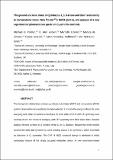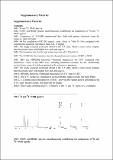Files in this item
The ground and ionic states of cyclohepta-1,3,5-triene and their relationship to norcaradiene states. New 1H and 13C NMR spectra, and analysis of a new experimental photoelectron spectrum by ab initio methods
Item metadata
| dc.contributor.author | Palmer, Michael H. | |
| dc.contributor.author | Aitken, R Alan | |
| dc.contributor.author | Coreno, Marcello | |
| dc.contributor.author | de Simone, Monica | |
| dc.contributor.author | Grazioli, Cesare | |
| dc.contributor.author | Hoffmann, Søren V. | |
| dc.contributor.author | Jones, Nykola C. | |
| dc.date.accessioned | 2020-04-10T10:30:01Z | |
| dc.date.available | 2020-04-10T10:30:01Z | |
| dc.date.issued | 2020-04-09 | |
| dc.identifier | 266761591 | |
| dc.identifier | d8aad8db-1a18-4d91-9469-43adc958af4b | |
| dc.identifier | 85083293589 | |
| dc.identifier | 000526711600001 | |
| dc.identifier.citation | Palmer , M H , Aitken , R A , Coreno , M , de Simone , M , Grazioli , C , Hoffmann , S V & Jones , N C 2020 , ' The ground and ionic states of cyclohepta-1,3,5-triene and their relationship to norcaradiene states. New 1 H and 13 C NMR spectra, and analysis of a new experimental photoelectron spectrum by ab initio methods ' , The Journal of Chemical Physics , vol. 152 , no. 14 , 144301 . https://doi.org/10.1063/1.5142268 | en |
| dc.identifier.issn | 0021-9606 | |
| dc.identifier.other | ORCID: /0000-0001-6959-5311/work/71954985 | |
| dc.identifier.uri | https://hdl.handle.net/10023/19779 | |
| dc.description.abstract | The strong inter-relationship between cyclohepta-1,3,5-triene (CHT) and norcaradiene (NCD) observed in some reactions, has been extended to include the energy surfaces for some low-lying ionic states. Whilst equilibrium structures of 2A/ symmetry containing the CHT skeleton were routinely found, the structures emerging with 2A// symmetry were found to be NCD ionic states. Surface studies, by variation of the C1 to C6 distance, showed minima for both state symmetries. Curve crossing which occurs in CS symmetry, is avoided by distortion to C1 symmetry. The CHT → NCD structural change is attributed to initial conrotatory closure of the singly occupied molecular orbital. A new synchrotron-based study of the photoelectron spectrum (PES) for CHT up to 25 eV shows little vibrational structure. We have assigned the overall PES up to 17 eV in considerable detail, using a variety of theoretical methods. The vertical ionization energy (VIE) sequence in the PES for CHT ions, is predicted to be: 12A/ < 12A// < 22A/ < 22A//. The calculated lowest ionic state, with lowest vibrational frequency 87 cm-1, leads to a high density of vibrational states. The Franck-Condon (FC) envelopes of the two lowest PES bands have been analysed. The identity of the PES spectrum, as derived from CHT rather than NCD, was demonstrated by 1H and 13C nuclear magnetic resonance (NMR) spectra of the sample; this agrees with the predicted PES spectra of CHT and NCD. The NCD predicted spectrum shows significant differences from CHT. | |
| dc.format.extent | 15 | |
| dc.format.extent | 5283176 | |
| dc.format.extent | 5616472 | |
| dc.language.iso | eng | |
| dc.relation.ispartof | The Journal of Chemical Physics | en |
| dc.subject | QD Chemistry | en |
| dc.subject | DAS | en |
| dc.subject.lcc | QD | en |
| dc.title | The ground and ionic states of cyclohepta-1,3,5-triene and their relationship to norcaradiene states. New 1H and 13C NMR spectra, and analysis of a new experimental photoelectron spectrum by ab initio methods | en |
| dc.type | Journal article | en |
| dc.contributor.institution | University of St Andrews. School of Chemistry | en |
| dc.contributor.institution | University of St Andrews. EaSTCHEM | en |
| dc.identifier.doi | https://doi.org/10.1063/1.5142268 | |
| dc.description.status | Peer reviewed | en |
This item appears in the following Collection(s)
Items in the St Andrews Research Repository are protected by copyright, with all rights reserved, unless otherwise indicated.


